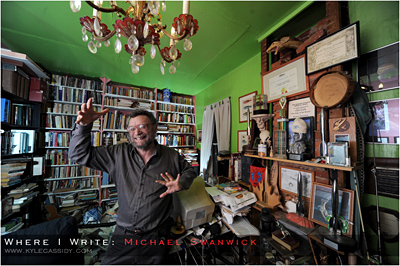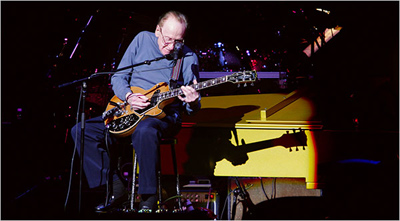

|
Archives
music
Woodstock at Forty "Along with 499,999 others on a countercultural pilgrimage 40 years ago, I was heading for the Woodstock Festival of Music & Love. I was wearing my yellow leather fringe jacket for the first time. In one of the pockets there was a nice little stash of LSD. If you happen to be brand-name conscious, then you’ll want to know that it was Owsley White Lightning. "The CIA originally envisioned using LSD as a means of control, but, without anybody’s permission, millions of young people had already become explorers of their own inner space. Acid was serving as a vehicle for deprogramming themselves from a civilization of sadomasochistic priorities. A mass awakening was in process. There was an evolutionary jump in consciousness. "The underground press was flourishing, and when LSD was declared illegal on October 10, 1966, the psychedelic San Francisco Oracle became politicized while the radical Berkeley Barb began to treat the drug subculture as fellow outlaws. Acid was even influencing the stock market. Timothy Leary let me listen in on a phone call from a Wall Street broker who thanked Leary for turning him onto acid because it gave him the courage to sell short. "As I wandered around the Woodstock Festival, I was overwhelmed by the realization that this tribal event was in actuality what the Yippies had originally fantasized about for Chicago. No longer did so many of these celebrants have to feel like the only Martians on their block. Now, extended families were developing into an alternative society before your very eyes. I had never before felt such a powerful sense of community." Kind of Blue at Fifty: Stalked by Bill Evans' Ghost "Miles Davis’ Kind of Blue was released 50 years ago this coming Monday—August 17, 1959. That was ten years after, and ten degrees cooler, than the little big band of Miles’ Birth of the Cool. With Kind of Blue the baby had grown up: sleeker, more earnest, now distrustful of irony, and also cagier, suspicious without wanting to show anything that might suggest defensiveness. Its icy hauteur sets the standard for art that draws you in by pretending it doesn’t need anyone or anything but itself. "Kind of Blue sold like cool-cakes. Its popularity has only increased over the years. Often said to be the best-selling jazz record in history, it attained quadruple platinum status by 2008; some four million copies have been sold in the US. "The recording took place on two days, six weeks apart, in 1959. First came the two three-hour sessions from 2:00 to 5:00 in the afternoon and 7:00 to 10:00 in the evening on March 2, 1959 in the converted church on 30th Street in Manhattan that was the Columbia studio. Union rate was then pegged at $48.50 per session, and since there were two services Davis’ sidemen were entitled to double scale. Davis argued for a bonus of $100 for the first days work for his stalwarts, bassist Paul Chambers and saxophonists John Coltrane and Cannonball Adderley. "As Ashley Kahn notes in his excellent Kind of Blue: the Making of the Miles Davis Masterpiece (Da Capo, 2000), the initial producer of the session, the producer Irving Townsend, whose voice can be heard on the studio sequences offered on this year’s anniversary re-issues, wrote in an internal Columbia Records memo that Davis would “accept an advance of $10,000 with only a mild oath” after the success of Birth of the Cool and the subsequent Sketches of Spain. Miles had asked for $15,000. It’s hard to know how much Miles made off the record in total, but it’s a lot." Since I am on a musical roll here (so to speak) my vinyl ripping project is finally producing WAV, FLAC, and MP3 files that I like. There are a lot of steps in this process that I will share one of these days. It's nice to here the music again. Granted, many of my LPs have been released on CD but it's nice to hear the music from the grooves that I grooved to in the 60s and 70s. Not to mention that some of the CDs that have been released aren't the same. Early Beatles are a good example. The English album and the US album had different song lists. The CDs are of the English albums. That may be all fine an good but those aren't the albums I listened to. Now I will be able to listen to the albums I want to listen to. And a lot of what I have on vinyl isn't available as a CD. Much enjoyment will ensue.
economy I linked to shortened version of this a while ago. Now the complete article is online. Read it and weap.
The Great American Bubble Machine "The first thing you need to know about Goldman Sachs is that it's everywhere. The world's most powerful investment bank is a great vampire squid wrapped around the face of humanity, relentlessly jamming its blood funnel into anything that smells like money. In fact, the history of the recent financial crisis, which doubles as a history of the rapid decline and fall of the suddenly swindled dry American empire, reads like a Who's Who of Goldman Sachs graduates. "By now, most of us know the major players. As George Bush's last Treasury secretary, former Goldman CEO Henry Paulson was the architect of the bailout, a suspiciously self-serving plan to funnel trillions of Your Dollars to a handful of his old friends on Wall Street. Robert Rubin, Bill Clinton's former Treasury secretary, spent 26 years at Goldman before becoming chairman of Citigroup — which in turn got a $300 billion taxpayer bailout from Paulson. There's John Thain, the asshole chief of Merrill Lynch who bought an $87,000 area rug for his office as his company was imploding; a former Goldman banker, Thain enjoyed a multibilliondollar handout from Paulson, who used billions in taxpayer funds to help Bank of America rescue Thain's sorry company. And Robert Steel, the former Goldmanite head of Wachovia, scored himself and his fellow executives $225 million in goldenparachute payments as his bank was selfdestructing. There's Joshua Bolten, Bush's chief of staff during the bailout, and Mark Patterson, the current Treasury chief of staff, who was a Goldman lobbyist just a year ago, and Ed Liddy, the former Goldman director whom Paulson put in charge of bailedout insurance giant AIG, which forked over $13 billion to Goldman after Liddy came on board. The heads of the Canadian and Italian national banks are Goldman alums, as is the head of the World Bank, the head of the New York Stock Exchange, the last two heads of the Federal Reserve Bank of New York — which, incidentally, is now in charge of overseeing Goldman — not to mention … "But then, any attempt to construct a narrative around all the former Goldmanites in influential positions quickly becomes an absurd and pointless exercise, like trying to make a list of everything. What you need to know is the big picture: If America is circling the drain, Goldman Sachs has found a way to be that drain — an extremely unfortunate loophole in the system of Western democratic capitalism, which never foresaw that in a society governed passively by free markets and free elections, organized greed always defeats disorganized democracy. "The bank's unprecedented reach and power have enabled it to turn all of America into a giant pumpanddump scam, manipulating whole economic sectors for years at a time, moving the dice game as this or that market collapses, and all the time gorging itself on the unseen costs that are breaking families everywhere — high gas prices, rising consumercredit rates, halfeaten pension funds, mass layoffs, future taxes to pay off bailouts. All that money that you're losing, it's going somewhere, and in both a literal and a figurative sense, Goldman Sachs is where it's going: The bank is a huge, highly sophisticated engine for converting the useful, deployed wealth of society into the least useful, most wasteful and insoluble substance on Earth — pure profit for rich individuals. "They achieve this using the same playbook over and over again. The formula is relatively simple: Goldman positions itself in the middle of a speculative bubble, selling investments they know are crap. Then they hoover up vast sums from the middle and lower floors of society with the aid of a crippled and corrupt state that allows it to rewrite the rules in exchange for the relative pennies the bank throws at political patronage. Finally, when it all goes bust, leaving millions of ordinary citizens broke and starving, they begin the entire process over again, riding in to rescue us all by lending us back our own money at interest, selling themselves as men above greed, just a bunch of really smart guys keeping the wheels greased. They've been pulling this same stunt over and over since the 1920s — and now they're preparing to do it again, creating what may be the biggest and most audacious bubble yet. "If you want to understand how we got into this financial crisis, you have to first understand where all the money went — and in order to understand that, you need to understand what Goldman has already gotten away with. It is a history exactly five bubbles long — including last year's strange and seemingly inexplicable spike in the price of oil. There were a lot of losers in each of those bubbles, and in the bailout that followed. But Goldman wasn't one of them."
photography
 Not only is the Where I Write series amazing but Kyle's other work is also more than worth looking at. And a blog:
israel/palestine
Mondoweiss keeps getting better and better in looking deeply at Zionism. Here is a remarkable essay by a Jew returning to Poland. It's followed be even more remarkable responses. All food for thought. At the root of this is the mythology of Zionism. A mythology that often has no base in reality. We shape our mythologies and then our mythologies shape us. In the beloved Old Country, a Jew has visions of her homeland "Last month I visited the Old Country for the first time. Poland. Land of my grandmother and grandfather, burial ground of countless unknown relatives. For six days, I wandered the country, and for six days I marinated in a deep nostalgia for a Jewish past I have never lived but have always felt far more connected to than, say, the Zionist-dominated present. "In one particularly moving episode, I walked the still-cobblestoned street where my grandfather walked as a boy, a narrow lane of Bialystok called Czysta Street where he, his parents, and eight siblings all lived [old homestead is pictured, below]. "In another, I celebrated, cake and all, what would have been my great-grandparents’ 118th wedding anniversary. I visited the synagogue in Tykocin where one of my great grandfathers might have prayed. And I roamed the overgrown cemeteries of Warsaw and Bialystok, wondering which of my relatives were buried there, marveling at the tangled breadth of what once was, mourning its loss, and puzzling over why, if we’re going to insist on having some kind of a “homeland,” so many Jews demand that it be Israel when it so clearly should be Poland. Poland, land of latkes and bialys. Poland shel zahav. "This, of course, isn’t the reaction you’re “supposed” to have. In the popular Zionist narrative, the Old Country – and the unspeakably murderous brutality that Jews suffered there – is the (non-Biblical) justification for the state of Israel. It’s the narrative stepping-stone that gets people from anti-Semitism to Eretz Yisrael, from colonization to justification, and a whole industry of books, teen tours, and UJA-style delegations has sprouted up to help cement the connection. "And yet, when I returned from my trip and one of my more Zionist relatives asked the inevitable question – “So now you understand why Jews need Israel, right?” – I still couldn’t say “yes.” For me, the Old Country opened up a very different set of narratives." A Polish-Canadian calls for healing between Poles and Jews "My dearest Jewish friend, Ms. Lizzy Ratner, "It warmed my heart to hear that your six-day sojourn through Poland’s cities, towns and villages led you to discover the one-thousand-year old history of Polish Jewry and to feel a deep personal attachment to the land of your ancestors which you wrote about in your article “In the Beloved Old Country, a Jew has Visions of her Homeland”. "I have been returning to Poland the last few years, to the country of my birth, which my family fled from communist persecution. I too feel that deep, inner longing to rediscover and connect to the Jewish half of the Polish soul, or is it the Polish half of the Jewish soul? "When I visit Poland, I make sure to take in the weeklong Festival of Jewish Culture at the end of June held in the Jewish district of Krakow, capped by thousands upon thousands of Poles crammed into the Old Jewish Square swaying to the best Klezmer music from around the world. Once, when I was employed in Warsaw for a few months, I called-in sick in order to travel to the city of Lodz, to run my fingers across the marvelous red-orange brickwork of the old textile factory owned by the Jewish magnate Izrael Poznanski—the king of cotton. Then onto to his home, the stunning baroque Poznanski Palace, now housing a museum dedicated to the history of Lodz, which resonates in my mind because of a picture of a remarkably cosmopolitan choir in pre-war Poland composed of one third Catholic Poles, one third Jewish Poles, and a third Germans. I took pictures of myself sitting next to the famous pianist Arthur Rubinstein or, rather, the life-sized bronze statue of him playing the piano on Piotrkowska Street. Of course, merriment aside, I also made the obligatory pilgrimage to Auschwitz, as well as Stutthof and Majdanek, to pay my respects to the victims of the German Nazis. "As long as I can remember, I was fascinated by Polish Jewish culture—the good and the bad. I was an odd boy, in that most of my friends at the Catholic School I attended in Canada read marvel comics and hardy boy novels, while I read Elie Wiesel and letters from Auschwitz. My friends, all Detroit Tigers fans, followed Kirk Gibson and Alan Trammell religiously, and I did too, but I also followed Pope John Paul’s visits to Auschwitz where he knelt and prayed, his visit to the Great Synagogue in Rome, and watched through tears as he placed a prayer in the Wailing Wall in Israel. "The words he issued commemorating the 50th anniversary of the Warsaw Ghetto Uprising still echo in my heart, “As Christians and Jews, following the example of the faith of Abraham, we are called to be a blessing to the world. This is the common task awaiting us. It is therefore necessary for us, Christians and Jews, to be first a blessing to one another”. "What I am trying to say, is that as a Polish-Catholic raised in a conservative Polish-Catholic home, I was and remain in search of an honest conversation between Poles and Jews, and I have to admit it is disheartening to find time and again the lines of communication between these two storied peoples, sharing a beautiful and tragic one thousand year old history to become, so corroded by anger and beset by a sclerosis due to politics and campaigns of misinformation that perpetuate misunderstanding." In this corner, assimilation. In that corner, Zionism "Reading Lizzy Ratner’s moving account of her visit to the old country prompts me to write. "One key point I felt was overlooked was the impact of Communism. It was Stalin more than anyone who stood in the way of allowing the surviving Jews of Europe to cast down their buckets, and thus it is indeed telling that he was the earliest endorser at the war’s outset of a Jewish state in Palestine. It is also worth noting in this context that the old country became the site of the greatest bloodbath in the history of mankind: the clash of the Red Army and the Wehrmacht. "Of course the Zionist obstruction of a Jewish recovery in Europe was a major force as well. Indeed, the much-storied Warsaw Ghetto uprising was effectively the last stand of the Jews who rejected Zionism in favor of an emancipated future in Europe. And the journalist most responsible for telling their story to the world, William Zukerman, was emphatic on this point. "If there is anyone in whose footsteps Phil Weiss is following, it is William Zukerman. After the founding of the State of Israel, the veteran Yiddish journalist wrote and published the Jewish Newsletter to keep alive the anti-Zionist tradition of the Yiddish-speaking socialist community until his death in 1961. Though apparently remaining an atheist in keeping with this tradition, Zukerman nonetheless cast his lot with the Reform Rabbis of the American Council for Judaism, acknowledging them as "the party of opposition in American Jewry." Significantly, the President of the ACJ, Lessing Rosenwald, distinguished himself as the leading voice in the wilderness urging the rescue and revival of European Jewry against the obstructionist aims of the Zionists." Does American Jewish political engagement reflect a shtetl outlook? "I took Lizzy Ratner’s recent blog, In the beloved Old Country, a Jew has visions of her homeland, to be a satire on Zionism, somewhat in the vein of Swift’s famous "modest proposal." Unfortunately, or perhaps by intent, Lizzy stirred up a bit of a hornet’s nest. And yet that may be for the good, because in one of her comments she raises an important question. Conjuring up "Zionists or ultra-religious folk who might happen to be reading this," she says, "they’ll accuse me of the greatest crime of all: of failing to understand the lessons of the Holocaust, of shrugging off centuries of hate." "And isn’t that the real question? What exactly are the "lessons of the Holocaust?" What lessons have been learned, and are the lessons that were learned those that should have been learned? For Neocons, the obvious lesson is that Jews need a Fortress Israel that they can withdraw to in time of persecution. I have actually had highly-educated and intelligent Jews tell me that–if persecution should arise they can always flee to Israel. Like, if they’re American neighbors start forming into murderous anti-Semitic mobs they’ll somehow be safe crammed cheek by jowl into a tiny Levantine state, in a world awash in nuclear weapons. The Neocon response to this objection, of course, is to enlist the United States in a global search and destroy mission to level any country that expresses hostility to Israel. I submit, without denying the real threats that face Jews, that that is a mistaken lesson, a false lesson."
les paul 1915-2009
 Les Paul, Guitar Innovator, Dies at 94 "Les Paul, the virtuoso guitarist and inventor whose solid-body electric guitar and recording studio innovations changed the course of 20th-century popular music, died Thursday in White Plains, N.Y. . He was 94. "Mr. Paul was a remarkable musician as well as a tireless tinkerer. He played guitar alongside leading prewar jazz and pop musicians from Louis Armstrong to Bing Crosby. In the 1930s he began experimenting with guitar amplification, and by 1941 he had built what was probably the first solid-body electric guitar, although there are other claimants. With his guitar and the vocals of his wife, Mary Ford, he used overdubbing, multitrack recording and new electronic effects to create a string of hits in the 1950s. "Mr. Paul’s style encompassed the twang of country music, the harmonic richness of jazz and, later, the bite of rock ’n’ roll. For all his technological impact, though, he remained a down-home performer whose main goal, he often said, was to make people happy." I loved listening to Les Paul and Mary Ford in the 1950s. I was as old as my grandkids Robyn and Mike. In 1976 he won a Grammy for Chester and Lester with Chet Atkins. I have that on vinyl. I bought it when it came out and it is amazing. The modern electric guitar exists because of Les Paul. Modern multi-track recording exists because of Les Paul. But, and I think most important of all, when I listen to his music or listen to him talk it makes my happy.
up for air I show up briefly gasping for air. I'm not exactly underwater (although the rains have returned -- hoorah!) but I am busier that a one armed paper hanger. This is actually a good thing. Too busy to even note that on August 10, 1999 I started this blog. 10 years! Camera strap sales have slowed down this month but that is usually followed by even more sales and I have a couple of things out there that will help with the increased sales. Last week was recovering from the week before getting ready for our annual purge and garage sale. Everything that went out for sale doesn't come back into the house. I've also being dragged into Facebook. I've resisted but Katie and Jenny in Colorado are on it and so is William in Afghanistan. School in Colorado starts August 11 (That's so wrong!) and Jenny sent pictures of grandkids getting off for their first day of school.
 Robyn (Jenny's oldest starting 5th grade)
 Mike (Katie's son starting 4th grade)
 Evan (Jenny's youngest starting Kindergarten)
|
|